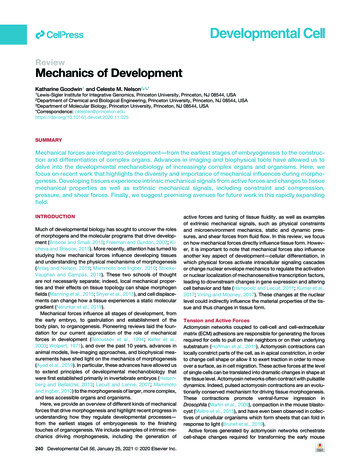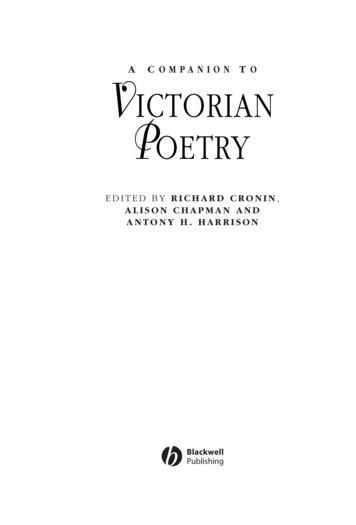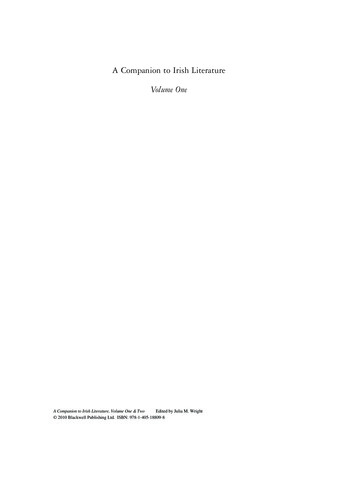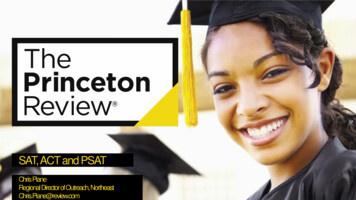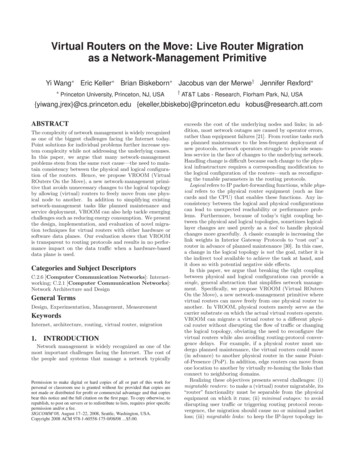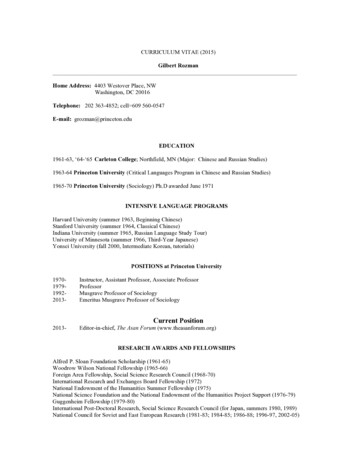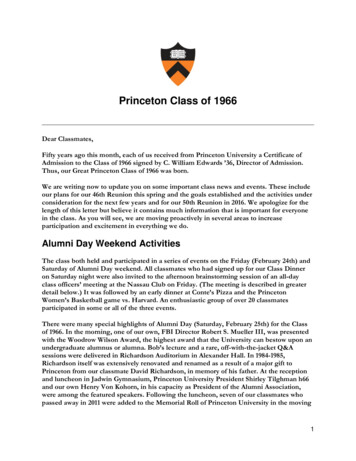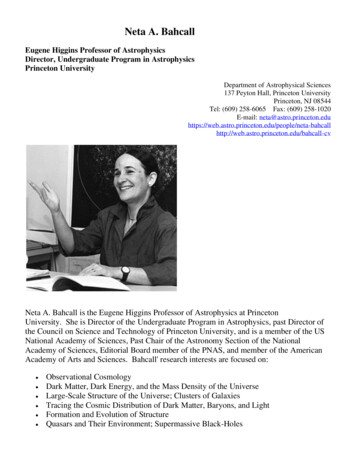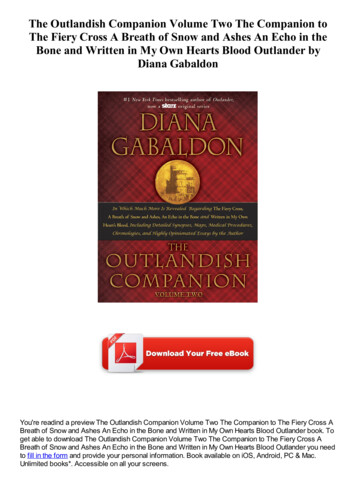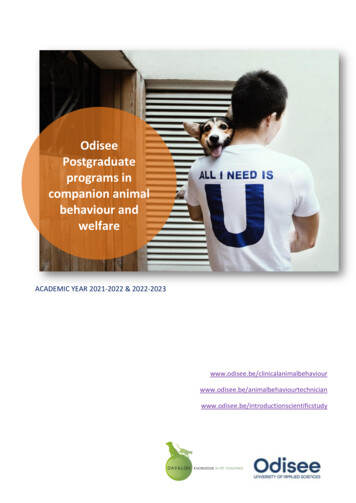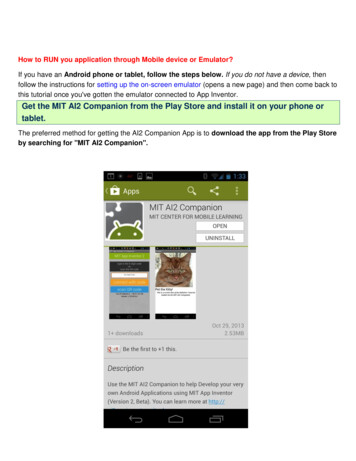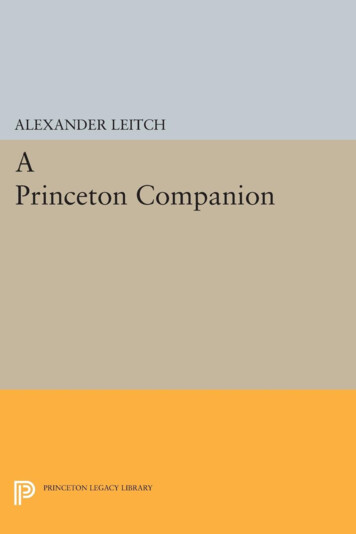
Transcription
A PRINCETON COMPANION
Sponsored by the Class of 1919,Princeton University
u f'PrincetonCompanion /ex{Jnder{!,itchPRINCETON UNIVERSITY PRESSPrinceton, New Jersey
Copyright 1978 by Princeton University PressPublished by Princeton University Press, Princeton, New JerseyIn the United Kingdom: Princeton University Press,Guildford, SurreyAll Rights ReservedLibrary of Congress Cataloging in Publication Data willbe found on the last printed page of this bookThis book has been composed in VIP CaledoniaPrinted in the United States of Americaby Princeton University Press,Princeton, New JerseyALEXANDER LEITCH '24 was an editor of the Princetonianand a member of the Press Club as an undergraduate.Thereafter he served the University for forty-two yearsunder Presidents Hibben, Dodds, andGoheen as director of student employment,director of public information,secretary of the Graduate Council,assistant to the president, and, from 1936 until his retirementin 1966, as Secretary of the University.
TO THE MEMORY OFMARY LANCASTER LEITCH1912-1972ALEXANDER LEITCH, JR.1943-1970MATRI FILIOQUEIN AMORE DEDICATUS
PREFACEhistory for which I lacked proper credentials. Accordingly, we three, in frequent meetings in our living room,worked out the idea for a book of articles in alphabetical order about everyfacet of Princeton life and history from1746 to the present that would be a useful work of reference and also one tobrowse in; and we called it A PrincetonCompanion. Until their deaths, theyboth contributed immeasurably to thepreparation of articles that set the modefor what was to follow. I have dedicatedthis book to their memory. The Latininscription I have used is taken fromthe Rothschild Arch (q.v.), which linksthe University Chapel and DickinsonHall.Still another pair of strong hands tookup work on the Companion when myold friend, Nelson P. Rose '31, in townfor the graduation of his secondPrinceton son, asked whether I didn'tneed research and editorial assistanceand then gave his own affirmative answer with a spontaneous and verygenerous gift for that purpose, anexample later followed by other eminent Princetonians. He helped in otherways, too. Carefully reading all themany articles I sent him for criticism,he helped clean up grammar andtighten syntax, quoted passages fromLincoln's second inaugural as examplesof alternatives to over-long sentences,supplied pithy anecdotes from a richlystored memory of his own undergraduate days, and always found somethingThe kind of book projected was the to commend.Presidents Goheen and Bowenwork of another triumvirate: my wife,my son Sandy, and me. Sandy, a mem- helped with funds at their disposal andber of the Princeton Class of 1965, then gave their enthusiastic encouragement,a graduate student at Harvard, advised as did Emeritus President Dodds.against my undertaking a conventionalMidway in the writing, financial supThis book is the work of many hands.Besides my own, there were, to beginwith, those of W. Beaumont Whitney,II, who persuaded the Class of 1919, ofwhich he was then president, to commit funds that might otherwise havebeen used for a fiftieth reunion classbook to the support of a badly neededPrinceton history. Then there werethose of my successor as Secretary ofthe University, Jeremiah S. Finch, whosuggested to the Class of 1919 that Imight make creditable use of theirfunds in my retirement years. Nextwere added, indispensably, those ofHerbert S. Bailey, Jr., Publisher to theUniversity, who endorsed the kind ofbook I proposed for publication by theUniversity Press. The foregoing triumvirate has for over a decade conspiredto devise every conceivable means tohelp get the job done, never publiclyadmitting the possibility that the authormight be finished before the manuscript. Beau Whitney has on a moment's notice come up to Princetonfrom Philadelphia whenever he wasasked, urging the project on with softspoken persistence. Jerry Finch, a master of clear and concise statement andwidely knowledgeable about all aspectsof Princeton, proved a valued consultant on style and content from beginningto end. Herb Bailey cheered the project on its way, kept matters withinmanageable limits, and toward the endwas instrumental in finding other handsto help speed it to completion.
VlIlport of the Companion, received amuch needed stimulus at the hands ofanother old friend of Princeton's and ofmine, Grant ("Bill") Oliver '25. Hischeerful persuasion brought substantialgifts from himself, Brooks Emeny '24,Dorothy Hubbell ['24], Lewis Mack'25, S. Barksdale Penick '25, T. Edmund Beck '26, Robert M. Walker '32,and Rawleigh Warner, Jr. '44. A fewyears later, when a further transfusionappeared necessary, Bill teamed withBeau Whitney to secure generous giftsfrom themselves, William A. Kirkland19, Ernest C. Savage 19, BenjaminStrong '19, Harold H. Helm '20, JamesF. Oates, Jr. '21, Brooks Emeny '24,Henry B. Guthrie '24, Rudolph J.Schaefer '24, Frank H. Connor '25, andHorace H. Wilson '25. All of thesePrincetonians, along with the Class of1919, merit the applause of all who findthe Companion to their liking.At about the same time, at the suggestion of Herb Bailey and Jerry Finch,an effort was begun to obtain the helpof faculty and alumni in writing certainarticles. Ultimately some seventy persons responded; their names will befound at the end of the articles theycontributed.Thesecontributions,which represent about a fifth of the contents, helped bring the book to earliercompletion; in not a few cases they gaveit added scholarly authority and literaryquality.Various faculty and alumni helped toenlist authors or to read and make suggestions about completed articles,among them—in addition to Bailey,Finch, Whitney, and Oliver—CarlosBaker, Morroe Berger, David P. BiIlington, Joseph L. Bolster, Jr., JohnTyler Bonner, Julian P. Boyd, J. Douglas Brown, W. Frank Craven, FredericE. Fox, Donald W. Griffin, Robert C.Gunning, David W. Hirst, Ernest F.PREFACEJohnson, Frances F. Jones, SheldonJudson, Richard A. Lester, Arthur S.Link, Dorothy Lupichuk, Henry D.Smyth, Lyman Spitzer, Jr., Joseph R.Strayer, Willard Thorp, Leslie L. Vivian, Jr., and Thomas H. Wright, Jr.,and my two old Princeton friends, AlanW. Carrick '23 and Frederick S. Osborne '24.As a member of the sponsoring Classof 1919, Doug Brown took a particularinterest in the project. Besides writingfour articles himself, the Emeritus Provost and Dean of the Faculty drew onhis long experience with the faculty tosuggest those I might ask to write articles and enlisted some recruits himselfover lunch at Prospect.Emeritus Davis Professor of American History, Frank Craven, anotherproductive writer and good recruitingagent, was an especially generous adviser and consultant. His door was always open and I went through it frequently to have my history checked andto be cheered by his good-humoredcounsel.Carlos Baker showed me how tosharpen the focus of a story along withother tricks he had learned in his longwriting career. On receiving a limp answer to his question about the Companion's progress when he encountered medragging my way up Nassau Street oneblustery March day, the Woodrow Wilson Professor of Literature volunteeredto take on another long piece—he hadalready done two—and arranged fortwo more excellent ones by a youngercolleague.Grateful acknowledgment is alsodue various other kinds of assistance.Useful suggestions about athletic articles were made by Asa S. Bushnell '21,Charles R. Erdman, Jr. '19, R. Kenneth Fairman '34, Samuel C. Howell'50, Gordon G. Sikes '16, Donald C.
PREFACEIXStuart, Jr. '35, Daniel F. Sullivan, and***Sanford G. Thatcher '65. Indispensable Those who have contributed theirarchival aid was provided successively means, their talents, and their time canby M. Halsey Thomas, F. James DaI- take satisfaction from knowing that theylett, Constance K. Escher, Edith have helped produce a volume thatJames, and Earle E. Coleman. An old provides in readily usable form detailedNew Hampshire hill-walking compan- information about the diverse elementsion and former Washington Post editor, of Princeton's heritage and its ongoingKenneth Dole (Harvard '24) gave a life. Included among some 400 articleshelpful perspective on a variety of arti- are the following:cles.Biographical sketches of 125 eminentI thank my daughter Margie and my Princetonians—all its presidents, someson Colin for many helpful suggestions deans, half a hundred other professors,and for their enduring warm support.and a number of trustees and otherWith the help of the gifts previously alumni. (Except in the case of the presmentioned, the Companion benefited idents, the Companion follows theby a succession of talented research and practice of other publications—e.g.,editorial assistants: Margaret Rindfuss, the Dictionary of American BiographyElizabeth Reilly '73, Phyllis Benjamin and the Dictionary of Scientific'76, Elizabeth Billington '76, Leslie Biography—and does not include aMitchner, and Stuart Mitchner. Be- sketch of any person living at the timecause their tenures were longest and the manuscript was prepared.)fullest, three of them merit specialmention. A member of the first co- Historical articles about Princeton'seducational class, Liz Reilly was able to trustees, its charter, its seal, and its ensupplement her conscientious and ef- dowment.fective work with helpful contemporaryinsights gained during her pioneering A description of the organization andfour-year passage through Princeton. A development of the Faculty, and hisfaculty daughter who served the Com- tories of all the University's departpanion longest, Elizabeth Billington's ments of instruction and research, andclear-headed and disciplined approach many of its special programs.to any problem presented to her and Similar accounts, fully exploring oriher fine sense of what is appropriate gins, of student social life, extracurricumade her an indispensable ally in every lar activities, and various branches ofphase of our work. Stuart Mitchner, an athletics.author with strong academic qualifications, brought to our project an experi- Accounts of the origin and developence in research and a skill with words ment of the preceptorial method of instruction, the four-course plan, and thethat made his contribution invaluable.honor system in examinations.In the closing stages we were fortunate to be under the capable guidance Articles about the annual commenceof Gail Filion, staff editor at the Uni- ment and baccalaureate exercises, honversity Press. Her experience, imper- orary degrees, the salutatory, the valturbability, and good nature did much edictory, and Princeton's centennial,to ease the way in bringing our en- sesquicentennial and bicentennial celdeavor to a successful conclusion.ebrations.
XPREFACEAn historical account of the development of the campus and of its differentarchitectural styles, and individual histories and descriptions of various of itsbuildings.tradition of national service, including asummary of Woodrow Wilson's Sesquicentennial address, "Princeton in theNation's Service," a list of Princetonalumni who were members of the Continental Congress, an account of thepart played by the Princeton membersof the Constitutional Convention of1787, and lists of those alumni who,since the nation's founding, have beenpresidents, vice-presidents, cabinetofficers, senators, representatives, supreme court justices, ambassadors,governors of states, and college anduniversity founders and presidents.Lists of Princetonians who have beenawarded Nobel and Pulitzer prizes andof faculty members who have beenelected to the different honoraryscholarly societies.In a book of this kind, errors of bothcommission and omission are bound tooccur, and I will appreciate being informed, through Princeton UniversityPress, of any the reader may find.An extended coverage of Princeton'sAlexander LeitchArticles on such varied features ofPrinceton—old and new—as its founding, its colors, its cheers, Nassau Hall,the origin of "Old Nassau"; and theComputer Center, the Third WorldCenter, and women at Princeton.Full accounts of alumni activities, especially the alumni college, the alumniparade, annual giving, and reunions.
A PRINCETON COMPANION
ADMISSIONAdmission to Princeton in the earlyyears was based entirely on a knowledge of Latin and Greek, but by 1760entering freshmen were required alsoto understand the principal rules of"vulgar arithmetic." The president ofthe College personally examined eachapplicant and determined whether ornot he should be admitted. Early onemorning in the 1790s, Titus Hutchinson, who had come down from Vermont, called at Tusculum to apply foradmission, and after morning prayersand breakfast with President Witherspoon, was grilled by him in Latin andGreek and admitted, with the understanding that he was to occupy the coming vacation with the studies in whichhe was behind. (Hutchinson graduatedwith honors in 1794 and later becamechief justice of Vermont.)Population was thinner then, and sowas the proportion seeking a collegeeducation. Writing to a trustee in 1803,Chemistry Professor John Maclean,Sr., ended his letter: "We got anotherstudent today." Thirty years later hisson, Vice-president John Maclean, Jr.,received a visit from James Moffat, atwenty-two-year-old immigrant printerfrom Scotland sent to see him by amutual friend, and after an hour's conversation about Latin and Greek, informed the young man, who had beenunaware of what was transpiring, thathe had been admitted to the juniorclass. (Moffat gave the valedictory atgraduation in 1835 and was later professor of classics in the College and thefather of five Princeton-educated sons.)Oral entrance examinations continued until well past the middle of thenineteenth century, when they beganto be superseded by written examinations, first given only in Princeton, andafter 1888 also at strategic points acrossthe country. With the founding of the3College Entrance Examination Boardin 1900, Princeton honored the board'sexaminations as well as its own, andafter 1915 required them of all applicants.The great increase in the number ofapplicants for admission to Americancolleges following the First World Warled the trustees in 1922 to adopt a policy of limited enrollment and selectiveadmission in order to preserve the essential features of Princeton's residential life and to maintain its standards ofindividual instruction. At the sametime they created the office of directorof admission, subsequently occupiedby Radcliffe Heermance, 1922-1950;C. William Edwards '36, 1950-1962;E. Alden Dunham HI '53, 1962-1966;John T. Osander '57, 1966-1971; Timothy C. Callard '63, 1971-1978; andJames W. Wickenden, Jr. '61, 1978- .During his twenty-eight years as firstadmission director, Radcliffe Heermance pioneered in the developmentof selective admission procedures, established close relationships with secondary schools in all parts of the country, and helped guide and develop theCollege Entrance Examination Board,of which he was chairman from 1933 to1936. Another pioneer during theformative years of selective admissionwas Psychology Professor Carl C.Brigham, who did innovative work inaptitude testing and was later chieflyresponsible for the development ofthe College Board's Scholastic Aptitude Test, first given in 1926.In the 1930s Princeton adopted aspecial plan of admission withoutexamination for students of exceptionalachievement and promise in the FarWest and South, where school programs did not fit them specifically forCollege Board examinations. Thanks tothis program and the missionary efforts
4of nation-wide Alumni Schools Committees, the geographical distributionof members of freshman classes wassubstantially broadened.This temporary Princeton solutionanticipated a more general and permanent one which came in 1940 when theCollege Board replaced examinationsbased on a set curriculum with objective tests that endeavored to cover thecommon elements of what was taughtin schools throughout the country. Thischange brought marked increases bothin the number of applicants for admission to Princeton and the number ofschools from which they came.A significant development, more recently, concerned blacks and otherminority groups. Although a few blacksstudied privately with President Witherspoon as early as 1774, and although,beginning in the last quarter of thenineteenth century, black students occasionally earned University degrees,the first appreciable influx did notbegin until the 1960s when the University adopted an active recruitment policy for minority students. By 1976, thefreshman class of 1980 includedninety-two black students and eightynine members of other minority groups—Puerto Ricans, Mexican Americans,native Americans, and Asian Americans.The admission process was furtherbroadened in 1969 when Princetonbegan undergraduate coeducation,with separate admission quotas for menand women. That year, 171 womenmatriculated, 69 as transferring sophomores, juniors, or seniors, 102 asmembers, along with 819 men, of thefreshman class of 1973. The trusteesadopted a policy of equal access for menand women in 1974 and at the sametime determined that the undergraduate body should remain at approx-ADMISSIONimately its existing size for the forseeable future. In 1976, the freshman classof 1980 numbered 736 men and 380women, drawn from a record numberof applicants—10,305.In meeting the responsibilities involved in a necessarily comprehensiveand painstaking process of selection,the admission director and his staffrely on help from alumni and undergraduates. More than 130 AlumniSchools Committees across the countryact as liaison between the Universityand secondary school students in theircommunities, helping the applicantsget a clearer picture of what Princetoncan offer them and making certain thatthe Admission Office has a full knowledge of each candidate's capabilities.On campus, an Undergraduate SchoolsCommittee helps prospective studentsobtain a first-hand acquaintance withPrinceton by arranging meals, overnight accommodations in dormitories,attendance at classes and lectures, andmeetings with faculty.In 1976 the University's admissionobjectives were summed up by Admission Director Callard in these words:Princeton seeks to enroll a studentbody that will be characterized byboth excellence and diversity. Whilethe University is interested in manykinds of excellence, superior pastacademic performance and significant promise for future academicgrowth must clearly be the fundamental considerations in evaluatingcandidates.But Princeton is no less interestedin the personal credentials of its applicants and is particularly concernedto find evidence of such qualities ofpersonal character as honesty andtrustworthiness, which are so crucialto the health of a residential uni-
AEROSPACE AND MECHANICAL SCIENCESversity community like Princeton's.Beyond personal integrity, the University is continually looking for evidence of such important qualities ascuriosity, initiative, energy, imagination, sensitivity, concern for others,commitment, persistence, creativity,leadership, and a sense of responsibility—qualities which clearly relateto academic as well as nonacademicaspects of an applicant's potentialperformance at Princeton, yet whichare sometimes more easily perceivedin the record of an applicant'snonacademic pursuits.The director of admission and hisstaff are responsible only for undergraduate admissions. Graduate admissions are made by the dean of theGraduate School after reviewing therecommendations of the departmentsconcerned.Advisory Councils for the academic departments were established in 1941.Each council consists of from three tofifteen members appointed by the trustees for three-year terms; nominationsare made by the departments in consultation with the Alumni Council. Membership is not restricted to alumni, butat least one member of each councilmust be an alumnus. Meetings for consultation and conference are held atsuch times as are mutually agreed uponby the advisory council and the department concerned. Close to 500 persons serve on some forty advisory councils.Aerospace and Mechanical Sciences,The Department of, which was formedin 1963 by a merger of the departmentsof Mechanical and Aeronautical Engineering, traces its roots back to theearly 1920s when Arthur M. Greene,5Jr. (q.v.), came to Princeton to establish a Department of Mechanical Engineering and to serve as dean of thenewly created School of Engineering(q.v.).Classes were held in the old Schoolof Science, with a makeshift laboratoryin a boiler house across WashingtonRoad, until the John C. Green Engineering Building was constructed in1928. Starting with only two youngassistants in mechanical engineering,Dean Greene taught over half thecourses in the department in additionto performing his administrative duties.Louis F. Rahm and Alfred E. Sorensonjoined the slowly expanding department in 1926; Lewis F. Moody as professor of fluid mechanics and machinedesign arrived in 1930.During the Depression, graduatingseniors, unable to obtain employment,returned for graduate study, spurringthe development of both the engineand hydraulics laboratories. By 1941,when Dean Greene retired and wassucceeded as dean and chairman byKenneth H. Condit, the Department ofMechanical Engineering was both wellstaffed and equipped, permitting it toacquit itself well during the hectic waryears when year-round teaching of military and civilian students was the orderof the day.In the summer of 1941, when theUnited States was developing thetechnological and industrial base thatwould give it world leadership in thedesign and manufacture of aircraft,Dean Condit invited Daniel C. Sayre(q.v.) to conduct a three-month study ofthe "possibility and desirability" of introducing courses relating to aeronautical engineering into the curriculum ofthe Mechanical Engineering Department.Although recognizing the limited na-
6AEROSPACE & MECHANICAL SCIENCESture of this original intent, the energetic and irrepressible Sayre made sucha strong case for the creation of a separate Department of AeronauticalEngineering that his suggestions wereadopted, and in early 1942 he foundhimself both Princeton's first professorof aeronautical engineering and thenew department's entire faculty.With keen competition for availabletalent in the rapidly expanding aeronautical field, building a departmentalstaff was not easy, but Sayre succeededin enlisting Alexander A. Nikolsky, whohad helped Sikorsky develop thehelicopter, and Harry Ashworth, askilled machinist and instrument expert. These three, aided by a fewgraduate assistants, and equipped witha small wind tunnel on a balcony ofwhat is now Aaron Burr Hall, were theentire department until the end of thewar. Then began a steady increase infaculty and a meteoric rise in achievement that culminated in the department's recognition as a leader in thefield by the mid-1950s.The first of the new faculty to arrivewas Courtland D. Perkins, fresh fromWright Field. Later, between variousleaves of absence to serve as chief scientist to the Air Force and as assistantsecretary of the air force for researchand development, Perkins pioneeredin-flight test analysis of aircraft stabilityand control. His research interests ledto the creation of the Flight DynamicsLaboratory, a unique facility for an academic institution, in which theory istested in actual flight.Rapidly outgrowing its balcony, thedepartment moved to a series of buildings near Lake Carnegie and to installations behind Palmer Stadium that hadhoused wartime research in physics.The plan of development aimed atmaintaining a strong undergraduateprogram, but concentrated on graduatetraining and research. A Master's program was begun with the inception ofthe department in 1942, a doctoral program in 1949.Experimental as well as analyticalresearch supported these graduate programs. The strange constructions withwhich Nikolsky's students probed theidiosyncrasies of helicopters caused interested comment. The racket of supersonic wind tunnels and rocket firingsbrought outraged protests. It was clearthat new quarters were needed.Already contending with the cancerthat would take his life five years later,Sayre spearheaded the effort that led tothe acquisition in 1951 of the propertyformerly occupied by the RockefellerInstitute for Medical Research and toits development as the James ForrestalCampus (q.v.). The University at lasthad a place to house research that, inSayre's words, "makes loud noises orbad smells," and the departmentmoved to these new quarters with alacrity. It was here that Charles Conrad,third man to walk the moon, completedhis undergraduate studies in 1953.Recognition of the stature the department had achieved came withHarry F. Guggenheim's selection ofPrinceton as the site for one of twojet propulsion research centers. (Theother was at the California Institute ofTechnology.) In 1954 Luigi Crocco ofthe University of Rome was appointedfirst Goddard Professor of Jet Propulsion. His work in combustion theoryalong with Martin Summerfield'sstudies of solid propellants had a profound effect upon rocket engine development during the next decade.In 1951 Sayre relinquished thechairmanship to Perkins in order togive full time to the direction of theForrestal Campus. Under Perkins, research activities expanded until therewere active programs in the entire
AFRO-AMERICAN STUDIESaerospace field, ranging from low speedflight to hypersonic reentry.In 1963, in recognition of overlapping interests, coupled with decliningenrollments in mechanical engineering, the two departments merged toform the Department of Aerospace andMechanical Sciences under Perkins'sleadership. Activities of the new department reached an all-time high in1967 with a research budget of almost 3.25 million and with an enrollment of140 graduate and 125 undergraduatestudents.The late 1960s and early 1970s weredifficult years. With increasing nationalanguish over war in Vietnam camecampus unrest and a wave of revulsionat the ills produced by the misuse oftechnology. Since the department wasdeeply involved in a technology closelylinked in the public mind withweaponry, it inevitably suffered decreasing enrollments and had to facecritical investigations to determine theappropriateness of its research on acampus greatly concerned with theneeds of humanity.That the research was demonstratedto be of high calibre and in no way unsuited to the University was not sufficient for the departmental faculty.With characteristic vigor they turnedtheir talents toward solutions of societalproblems. Research narrowly aimed ataircraft systems broadened its focus toinclude all modes of transportation.Combustion investigations moved fromstudies of rocket motors to problems ofnoise, of air pollution, and even of thedangers of smoking. Gas dynamiciststurned to problems of energy conversion and control, while the aerodynamicists, not to be outdone, started workon high efficiency windmills for powergeneration.By 1974, as Perkins retired as chairman, the changes had had effect. En-7rollments were recovering, researchbudgets were expanding, and the department, under the new leadership ofSeymour M. Bogdonoff, was facing thefuture with confidence.David C. HazenAfro-American Studies Program, The,was organized in 1969 to concern itself,the faculty committee said, "with thehistory, the culture and the currentsituation of twenty-five million Americans of African origins." Earlier in the1960s, interdepartmental interest inthis field had been focused in two research conferences on scholarly approaches to Afro-American Studiesheld under the auspices of the StrausCouncil on Human Relations. In theprogram's first year, twenty-six undergraduates—half of them white—concentrated in Afro-American Studies,and more than 500 took one or more ofits elective courses.In the belief that "the black experience is a special case of American experience," the program was designed toprovide an opportunity for interdisciplinary and comparative study "of theposition and experience of people of African ancestry in the United States,seen in relation to the experience ofblack people in other parts of theworld."The program is supervised by an interdepartmental committee and involves twelve cooperating departmentsand schools: Anthropology, The Schoolof Architecture and Urban Planning,Art and Archaeology, Economics, English, History, Philosophy, Politics, Psychology, Religion, Sociology, and theWoodrow Wilson School. Studentsenter the program through one of thecooperating departments or schools.In the program's early years, theUniversity received an 88,300 grant
8from the Ford Foundation for the development of undergraduate AfroAmerican studies and a 215,000 grantfrom the Rockefeller Foundation for thesupport of graduate studies and facultyresearch.F. Sheldon Hackney, a specialist inthe history of the American South, waschairman of the committee that designed the program. Chairmen of theprogram have included C. SylvesterWhitaker, Jr. (Politics), John R. Willis(Near Eastern Studies), and since 1973,Howard F. Taylor (Sociology).Alexander, Stephen (1806-1883), underwhose influence astronomy first developed as a separate discipline atPrinceton, graduated with honors fromUnion College at eighteen. A cousinand also a brother-in-law of JosephHenry (q.v.), he collaborated withHenry in his scientific investigations atAlbany Academy and accompanied himto Princeton in 1832, when Henry became professor of natural philosophy.Appointed tutor in mathematics in 1833and professor of astronomy in 1840, Alexander's association with the Collegecontinued for fifty years.Alexander gave Princeton's first discrete course in astronomy; he was wellliked by his students, who called him"Stephy." The College's first astronomybuilding, the Halsted Observatory,which stood on University Place fr
Sponsored by the Class of 1919, Princeton University . u f 'Princeton Companion /ex{Jnder {!,itch PRINCETON UNIVERSITY PRESS Princeton, New Jersey . . in 1966, as Secretary of the University. TO THE MEMORY OF MARY LANCASTER LEITCH 1912-1972 ALEXANDER LEITCH, JR. 1943-1970 MATRI FILIOQUE IN AMORE DEDICATUS .
